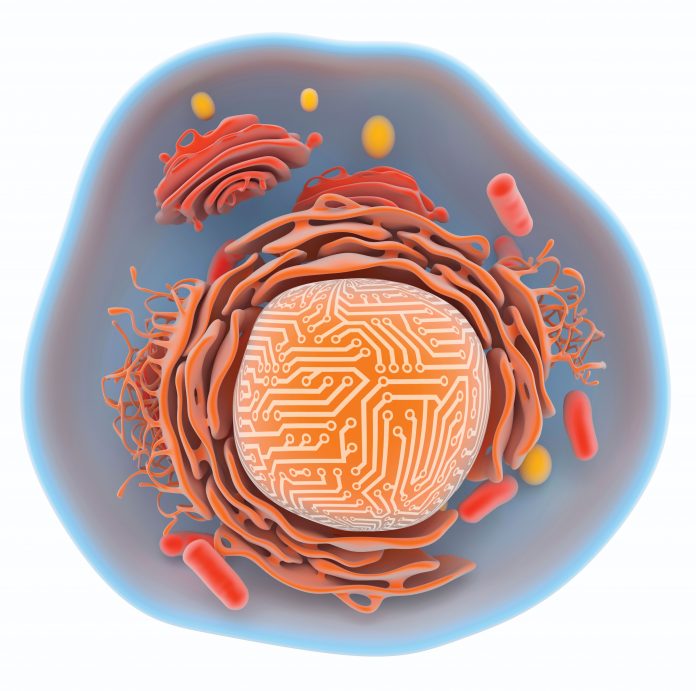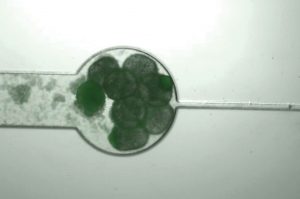
Building a switch doesn’t sound like a spectacular feat of engineering. But when that switch is constructed of DNA and designed to operate within the context of a living cell, it represents a far more impressive accomplishment.
The construction of a genetic toggle switch was reported 20 years ago in Nature, in an article contributed by Boston University researchers.1 The researchers, led by James J. Collins, PhD, described how the switch, through its sensitivity to culture conditions, was capable of efficiently turning bacterial genes on or off.
In the same issue of Nature, an article contributed by Princeton University researchers presented a genetic switch for driving a sort of biological clock.2 The clocksmiths, Michael B. Elowitz, PhD, and Stanislas Leibler, PhD, related how they assembled a synthetic network of three genes that could regulate one another to produce an oscillating output, with each of the three genes sequentially switching each other on and off for extended periods of time.
These two landmark efforts helped lay the foundation for the dynamic field of synthetic biology, and scientists are now designing and assembling a variety of increasingly sophisticated molecular circuits. “Synthetic biology is, in essence, a way to write programs—except in this case the computers are cells, and the programs are the genetic materials we introduce into them,” says Duke University researcher Lingchong You, PhD.

The researcher and his fellow biological coders are engineering circuits that could boost the potential of cells as biomanufacturing platforms, produce next-generation therapies for precision medicine, or inform the development of “smart,” environmentally responsive materials. But achieving these goals will require a concerted effort from engineers, biologists, chemists, computer scientists, and a host of other experts.
“In the 20 years since that early work, we [gained] a deeper understanding of biology and an appreciation that we can’t just move genetic parts from point A to point B and expect them to behave the same way,” stresses Tara L. Deans, PhD, of the University of Utah. “It’s a very interdisciplinary effort, and I think as long as we continue that, we’re going to keep making huge strides.”
Community organizers
Lingchong You initially came to the field as a chemical engineer, specializing in mathematical modeling. But as he began applying his expertise to characterize the function of biological networks within cells and across communities of cells, he became increasingly interested in the potential of actively manipulating their behavior.
“I wanted to test the extent to which our mathematic predictions will actually withstand the challenges of the real world,” he recalls. Today, much of his laboratory’s work is focused on reprogramming bacteria and altering the interplay between different populations of cells within complex communities.
In one recent study, You and colleagues engineered Escherichia coli bacteria to develop a versatile platform for controlled manufacturing of biopharmaceuticals.3 The platform incorporated tiny, porous polymeric capsules containing bacteria that had been genetically manipulated to express various therapeutic proteins. It also incorporated a synthetic circuit encoding a self-destruct switch.
As the platform’s encapsulated bacteria grow, they produce a change in pH that causes the capsule to shrink. In parallel, the self-destruct circuit steadily produces a toxic compound that causes the bacteria to rupture upon reaching a critical cell density, at which point they release their protein payload.
When the capsules shrink, they squeeze out the contents that the cells have produced. Subsequently, the capsule shrinkage reverses, and one can then reboot the whole cycle by adding glucose to the culture, which both stimulates bacterial growth among the survivors and temporarily inactivates the self-destruct circuit so that the cells can replenish.
This approach could enable controlled, small-scale manufacture of a wide range of drugs, and You notes that one can mix different combinations of encapsulated engineered bacteria—or as he terms them, “microbial swarmbots”—at defined ratios to create customized assembly lines.
“We want to use this as a platform to reconstruct metabolic pathways of interest,” he reveals. “We can use this platform to optimize the ratio of different enzymes to maximize the efficiency of the overall metabolic pathway in a very convenient manner.”
In an early study, You and colleagues showed that they could generate microbial swarmbots that produce 25 different proteins. The scientists even successfully recreated a seven-enzyme fatty acid biosynthesis pathway.
You’s group is also looking into strategies for genetically rewiring bacteria to alter how they self-organize in response to changes in their environment, including interactions with other microbial species. “We’re fascinated by the notion of creating living, functional materials,” he emphasizes.
The resulting artificial communities could offer valuable insights into the dynamic behavior of complex bacterial populations like those that reside within the human gut and other tissues, populations that are known to have a profound influence on our overall health and risk of developing various diseases. “We could,” suggests You, “introduce these materials into the gut to modulate microbiome dynamics toward a healthy state or minimize perturbations from antibiotic use.”
Manipulating materials
Synthetic biology often regards the cell as a vessel for an engineered genetic circuit, but the cell isn’t always necessary. In fact, the cell can be a detriment if it performs poorly as a “black box.” In synthetic biology, a black box is system that consists (mostly) of obscure subsystems that carry out routine biological activities. A cell makes a poor black box if it generates too much background noise and prevents the engineered genetic circuit from operating as intended.
As an alternative, some researchers turn to cell-free extracts—defined mixtures of enzymes and other biomolecules—to achieve greater control over the environment in which their circuits operate. “Cell-free systems are quite predictable,” says Elisa Franco, PhD, a researcher at the University of California, Los Angeles. A system is predictable to the extent its designed circuits perform as expected.
Cell-free platforms can facilitate the prototyping of circuit designs that are eventually adapted for use in cells, but much of Franco’s work is intended for noncellular environments. “There’s a lot of interest now in understanding how to build synthetic materials using biological molecules,” she notes, “and in harnessing how biology manages those materials.”
DNA and RNA are particularly useful building blocks in this context, because they readily self-assemble based on the interactions that naturally occur between nucleotides. And since these pairings between nucleotides are so predictable, one can design a remarkable variety of two- or three-dimensional structures based entirely on DNA or RNA scaffolds.
In one recent demonstration, her group showed how a simple synthetic oscillator circuit in a cell-free extract could control the assembly and disassembly of DNA-based nanotube structures.4 This oscillator can produce a disruptive RNA strand that can bind to DNA sequences within the nanotube, causing the structure to disintegrate. But after a certain amount of time, the oscillator switches itself off, and the RNA sequences begin to degrade, allowing the DNA nanotubes to reassemble once again.
This relatively simple proof of concept could offer a starting point for building more sophisticated smart materials in the future—for example, structures that can change their shape or texture on command, or building blocks that naturally “grow” into a shape that is useful for construction. “DNA for us is kind of a toy,” Franco declares. “It’s a Lego kit for learning the principles.”
But Franco also sees potential to directly apply these tools inside the cellular environment. Filaments based on proteins such as actin and tubulin form the natural infrastructure of cells, and they play a key role in the organization and trafficking of biological components. Franco is optimistic about placing similar filaments based on RNA or DNA under the control of synthetic gene circuits. Doing so could help developers manipulate these same processes, facilitating applications such as cell-based biomanufacturing.
“We could aggregate the components of a certain metabolic pathway in a particular area of a cell,” she explains. “And then with a particular input from the environment, we could eliminate that metabolic pathway and switch on something else.”
Moving into mammals
In general, progress in mammalian cell circuit engineering has lagged that in simpler models such as E. coli and yeast. When Deans first began working with rodent and human cells as a PhD student in the Collins laboratory some 15 years ago, she joined what was then a very exclusive club. “There were,” she recalls, “probably only three or four groups in the world working on mammalian synthetic biology at the time.”
Deans helped develop a genetic switch that could be selectively activated by bathing cultured mammalian cells in an activator compound.5 Subsequently, she participated in even more ambitious work. “I always had a vision of applying synthetic biology to human health,” she says. “It’s one thing to put a circuit into cultured cell lines, which basically do whatever you want, but putting something into stem cells is totally different.” To pursue her vision, she took a temporary hiatus from synthetic biology to focus on stem cell biology for her postdoc—and today, her laboratory’s work unites these two interests.
In 2017, her group published a proof-of-concept paper demonstrating the introduction of a simple circuit conferring chemical control over gene expression into mouse embryonic stem cells.6 As a next step, Deans is looking to introduce circuits that are far more complex circuits and capable of orchestrating the stepwise gene expression events necessary to efficiently convert immature stem cells into different kinds of differentiated cells.
This will be no mean feat. One lesson from her first foray into stem cell engineering is that foreign DNA often tends to get silenced after transplantation, and bigger circuits may pose bigger problems in this regard. “Our circuits are pretty gigantic,” she points out, “So, we’ve been looking for different ‘safe harbor’ loci in the genome, and we’re also trying to split up the circuit and put it in different places in the chromosomes.”
Her laboratory’s current objective is to engineer human stem cells that give rise to megakaryocytes, which are cells that spawn platelets, the tiny membrane bubbles whose primary function is to deliver the proteins that facilitate clotting in the aftermath of injury.
“They do a really good job of carrying a ton of proteins around the body,” says Deans. “We’re aiming to reengineer them to fill them with different kinds of pharmaceutical or therapeutic proteins.” In principle, it should also be possible to engineer the parent megakaryocytes to produce other membrane proteins that help target the modified platelets to specific, disease-affected tissues in the body.
This effort is still at a relatively early stage. Her group is now producing platelets, but it has not yet begun to modify or manipulate them. Nonetheless, industry representatives have already come knocking. “I had a meeting with some people that already want to fast-track this,” she reveals. “If I partner with the right people, I think commercialization might come sooner rather than later.”
References
1. Gardner TS, Cantor CR, Collins JJ. Construction of a genetic toggle switch in Escherichia coli. Nature 2000; 403(6767): 339–342.
2. Elowitz MB, Leibler S. A synthetic oscillatory network of transcriptional regulators. Nature 2000; 403(6767): 335–338.
3. Dai Z, Lee AJ, Roberts S, Sysoeva TA, Huang S, Dzuricky M, Yang X, Zhang X, Liu Z, Chilkoti A, You L. Versatile biomanufacturing through stimulus-responsive cell-material feedback. Nat. Chem. Biol. 2019; 15(10): 1017–1024.
4. Green LN, Subramanian HKK, Mardanlou V, Kim J, Hariadi RF, Franco E. Autonomous dynamic control of DNA nanostructure self-assembly. Nat. Chem. 2019; 11(6): 510–520.
5. Deans TL, Cantor CR, Collins JJ. A tunable genetic switch based on RNAi and repressor proteins for regulating gene expression in mammalian cells. Cell 2007; 130(2): 363–372.
6. Fitzgerald M, Gibbs C, Shimpi AA, Deans TL. Adoption of the Q Transcriptional System for Regulating Gene Expression in Stem Cells. ACS Synth. Biol. 2017; 6(11): 2014–2020.


